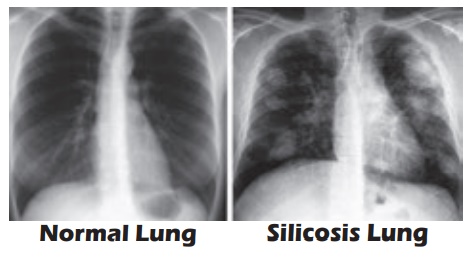Non Communicable Diseases - Causes, Risk factor, Signs and Symptoms, Diagnosis, Management, Complication - Occupational Disorders | 12th Nursing : Chapter 3 : Non Communicable Diseases
Chapter: 12th Nursing : Chapter 3 : Non Communicable Diseases
Occupational Disorders
OCCUPATIONAL DISORDERS
·
Silicosis
·
Computer Vision Syndrome
1. Silicosis
Silicosis, also known as
Pottor’s rot is a form of occupational lung disease caused by inhalation of
crystalline silica dust and is marked by inflammation and scarlingin forms of
nodular lesions in the upper lobes of the lungs.

Causes
Silicosis is caused by
exposure to crystalline silica and breathing in tiny bits of silica, which
comes from chipping ,cutting , drilling ,or grinding soil ,sand , granite ,or
other minerals.
Signs and Symptoms

·
Dyspnea exacerbated by exertion
·
Cough, often persistent and sometime severe
·
Fatigue
·
Tachypnea
·
Loss of appetite and weight loss
·
Chest
·
Fever
·
Gradual dark shallow rifts in nails eventually leading to crack as
protein fibre with in nails beds are destroyed
In advance cases:
·
Cyanosis
·
Corpulmonale
·
Respiratory insufficiency
Investigation
•
History collection
•
Physical examination
•
Chest X-ray reveals findings consistent with silicosis
•
Pulmonary function testing: may reveal airflow limitation,
restrictive defects, reduced diffusion capacity, mixed defects or may be normal
(in uncomplicated)
Management
Silicosis is an
irreversible condition with no cure. Management options currently focus on
alleviating the symptoms and preventing complications. These include:
•
Stopping further exposure to silica and other lung irritants,
including tobacco.
•
Cough suppressants
•
Antibiotics for bacterial lung infection
•
TB prophylaxis for those with positive tuberculosis skin test
•
Chest physiotherapy to help the bronchial drainage of mucus
•
Oxygen administration to treat hypoxemia, if present
•
Bronchodilators to facilitate breathing Lung Transplantation
Nursing Management
•
Providing nursing care in the acute and chronic stages
•
Health education regarding the prevention of the disease
Prevention
•
Rigorous dust control measures like wearing mask improving the
ventilation of work place
•
Water spray is often used where dust is present
•
Dust can also be controlled by dry air filtering
2. Computer Vision Syndrome
About two hundred years
before, the word “computer” started to appear in the dictionary. Some people
even didn’t know what is a computer? However, most of the people today not just
knowing what is a computer, but understand how to use a computer. Therefore,
computer becomes more and more popular and important to our society. We can use
computer everywhere and they are very useful and helpful to our life. But still
we are facing a problems like computer vision syndrome. Let us learn in detail.
Computer vision syndrome
(CVS) is strain on the eyes that happens when you use a computer or digital
device (Smart phone, Tablets, Laptop) for prolonged periods of time.

Causes
•
Lighting in the room
•
Distance from the screen
•
Glare on the screen
•
Seating posture
•
Angle of your head
Signs & Symptoms
•
Eyestrain
•
Dry eyes
•
Headache
•
Neck and
•
Blurred vision
•
Shoulder pain
Management
With these simple
practices, you can reduce the effects of computer vision syndrome:
•
Make sure the lighting in the room is comfortable on the eyes, and
prevents you from starting into glare on the computer screen
•
Position the digital display so that your head is in a naturally
comfortable position while using take breaks
•
A few minutes away from the computer can go a long way when it
comes to your eyes. Think of it similarly to the way you take stretch breaks
for your arms and back
•
Make sure your seat is comfortable. A comfortable chair with
support for your neck and back will help you avoid neck and shoulder strain
commonly associated with computer vision syndrome
Computer eye strain steps for relief
•
Get comprehensive eye exam
•
Use proper lighting
•
Minimize glare
•
Upgrade your display
•
Adjust your computer display setting
•
Blink more often
•
Exercise your eyes
•
Take frequent breaks
•
Modify your work stations
•
Consider computer eyewear
The Role of the NCD Nurse
•
To identify patients at high risk of developing an NCD through
risk assessment procedures for chronic diseases like diabetes and hypertension.
•
To provide advice, and help those with an already diagnosed
condition to manage their disease which ranged from health advice to social
issues that concerned participants.
•
To provide direct services to their clients who included
facilitation of support groups, health education, distribution of medication as
well as rehabilitation exercises.
•
As facilitators of support groups consisting of clients with
diabetes and/ or hypertension.
•
To provide education pertaining to nutrition in the management of
NCDs as well as explaining about risk factors, symptoms and preventive measures
for diabetes and hypertension.
•
To distribute medications for selected clients assigned in their
households and at the designated support groups.
•
For rehabilitation services in assisting clients with
rehabilitation exercises including other support groups enabling them to better
manage their conditions.
•
To link clients with the health system where the high risk cases
are identified and then referred the clients to the nearest health facilities.
Referred clients were given a referral letter by the nurse to present to the
health facility.
•
Capacity building through peer educator where NCD nurses learn
skills required to fulfil daily tasks ‘on-the-job’.
•
Administrative role includes completing forms with information
relating to the clients on a daily basis. In addition, completing daily
statistic sheets of clients and submitting to the coordinators on the next day.
NCD nurses are also responsible for collecting the signatures of clients when
they receive medication, so as to keep a record of the clients who have
collected their medication.
Related Topics